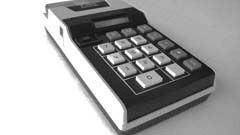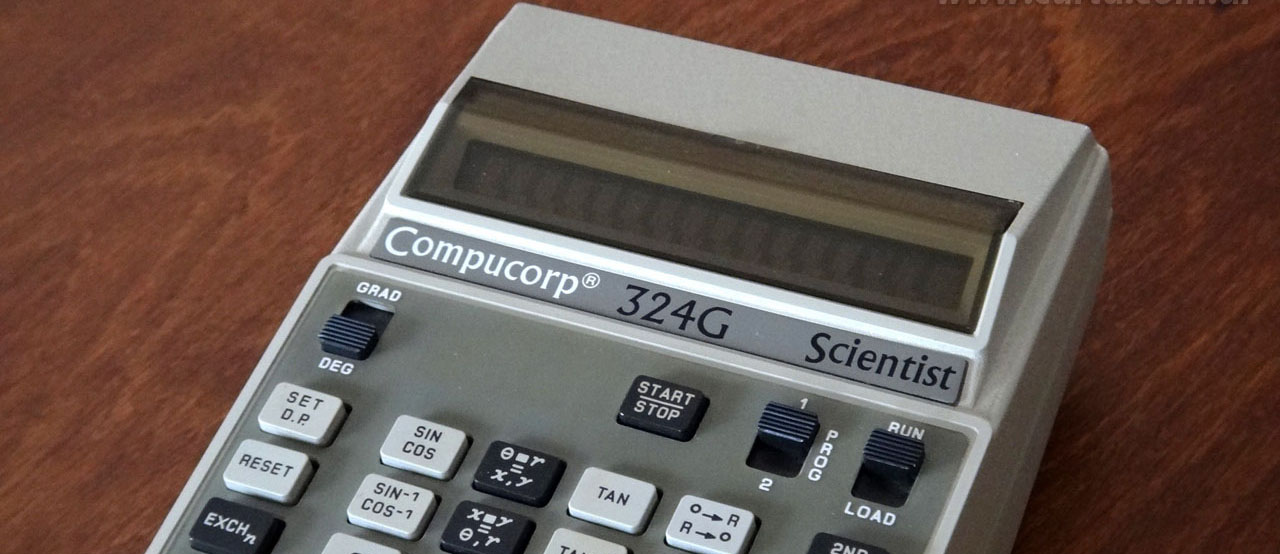Collection Item |
 |
Compucorp 324G
 |
| Brand: | Compucorp (Computer Design Corporation). |
| Model: | 324G. |
| Origin: | Los Ángeles, California, USA. |
| Introduction: | 1973. |
| Type: | Portable scientific and programmable calculator, operates with 4 D batteries and AC power. |
| Functions: | Scientific calculator with simple programming capability. No permanent memory. Only display, no printer. |
| Display: | Panaflex II display with 16 digit. Each digit contains 7 standard segments for numerals plus 2 indicators for decimal point and thousands separator. Negative numbers are displayed with "-" at the left of the first digit. Overflow error is displayed as "E---". |
| Keyboard: | 43 big keys plus 3 sliding switches for Angle Selection (gradients or degrees), Program to load or run (1 or 2), Operation mode (Normal/Run or Load Program). |
| Main chips: | Texas Instruments. |
| Logic comments: |
Scientific calculator with 4-basic functions plus: SIN, COS, TAN, ARC SIN, ARC COS, ARC TAN, LN, LOG, e^x,
10^x, a^x, PI, Square Root, 1/x, Change Sign, Conversion between polar and rectangular coordinates system, between degrees and
radians, between decimal notation and degrees/minutes/seconds. Scientific notation with mantissa and exponent. Also has 10 internal
registers (0 to 9) to store data. You can input expressions in algebraic mode, not RPN or pseudo-RPN very used in scientific calculators of that era. For example: To compute 2x3 you simply enter 2 x 3 =. You can use 1 level of parenthesis for complex expressions. The 2ND FUNC key is used to show the second function of a 2-function key in a particular way: You press a 2-function key and then (not before!) press 2ND FUNC. For example: If you want to compute a COS 25 you must enter: 25 SIN/COS and then 2ND FUNC. First you will see the result of SIN 25 and after pressing 2ND FUNC you will see COS 25. Rare! The programming model is very simple: The calculator remembers the sequence of keys that you press. There is no branching or conditional instructions, so the programming may be quite challenging but not impossible. Also, there is no edit or review capability of an existing program. If you make a mistake, simply you must type the whole program again from the start! Also, there is no permanent memory or a backup device (like the Compucorp/Monroe 326 Scientist), You power off the machine and the program is lost. When you run a program the machine executes all steps and then starts at step 1 again. This loop continues until you press START/STOP or raise an error condition, so an error condition may be a good way to stop the program. For example, you can store in a register the number of loops to run. In each loop you decrement this register by 1 and then compute 1/X. When the register reachs the value 0 the 1/X function will produces an error and the program will stop, genius! The only "control" instruction you have is the START/STOP key. If you insert this key into a sequence the program will pause at this point. You can read the display register and you can enter new data. This is a true input/output instruction! Now we'll see in brief the function of each key: Switch GRAD/DEG: Selects angle mode in Gradients (100º) or Degrees (90º). Switch PROG: Selects between program areas 1 and 2 to load or run. Each area holds up to 80 step program. Each step is aprox. a keystroke. Switch RUN/LOAD: Selects operation mode: RUN is for normal use of the calculator or to run a stored program of the selected area. LOAD is for store the following keystroke into the selected program area until you select RUN again. Remember: ALL keys will be stored, there is no editing key or possibility of re-input a wrong entry!. START/STOP: In RUN mode is used to run or stop the program in the selected program area. In LOAD mode will insert a pause into the program in order to view the display content and input new data. SET D.P.: Set Decimal Point position. Press this key and then a digit 0 to 9 of decimals to show on the display. RESET: Resets machine except registers 0 to 9 and program areas. EXCHn, STn, RCLn: Control of internal registers: Press this key and then a digit 0 to 9 to select the particular register to use. EXCHn (Exchange) is used to exchange the content between the selected register and the display. STn (Store) is used to copy the display content onto the selected register. RCLn (Recall) is used to copy the register content to the display register. You can combine STn with +, -, X and ÷ to store a computed result in a register. For example: STn + 5 adds the display register to register 5 storing the result in register 5. The same for RCLn plus +, -, X and ÷ to show a computed result on display. For example: RCLn X 9 multiplies Register 9 by display and store the result on the display register. CLEAR ENTRY: Clears last entry. SIN/COS, SIN-1/COS-1, TAN, TAN-1: Trigonometric direct and inverse functions. Remember: to see COS-1 and TAN-1 you must press 2ND FUNC after this key. Ln/LOG, e^X/10^X: Logarithmic direct and inverse functions. ø,r=x,y, x,y=ø,r: Converts Polar coordinates to Rectangular coordinates and vice-versa. º-›R/R-›º: Converts Gradients or Degrees (depending on the switch GRAD/DEG) to radians and vice-versa as a second function. DEC-›D.MS, D.MS-›DEC: Converts decimal notation to Degrees/Minutes/Second notation and vice-versa. 2ND FUNC: Shows the second function after pressing a 2-function key. Pi, Square Root, 1/X: Pi constant, Square Root and Reciprocal. a^x: a raised to x. 0 to 9 and .: Numerals and decimal point. EXP: Input the exponent part of a number in scientific notation. CHG SIGN: Change sign of mantissa or exponent. +, -, X, ÷: Add, Subtract, Multiply and Divide in algebraic mode. (, ): One level of parenthesis. =: Computes the final result of an algebraic expression. Now I will show you a simple program to compute the factorial of an integer number. The factorial is defined as the product of this number and all integer numbers below. For example: Factorial of 5 is 5x4x3x2x1 = 120 (of course, x1 is not nedeed!). We will use two internal registers: Register 0 to store the number of loops to run (will be decremented by 1 in each loop) and Register 1 to store the result of the factorial (will be multiplied by the content of register 0 in each loop). Before inputting the program we must "prepare" the computer: We must store the number of loops to run in register 0 (the argument of the factorial) and we must store 1 in register 1 (initial value of the factorial). You must enter: n STn 0 (n is the argument of the factorial) 1 STn 1 Now we will input the program at the program area #1 (remember we have 2 program areas), you must set the switch PROG in position 1 and set the switch RUN/LOAD in position LOAD. Then type the following program, only 5 instructions: RCLn 0 STn X 1 - 1 = STn 0 1/X That's all! What means this?: Step 1: Copies the content of register 0 into the display. Step 2: Multiplies the display by the content of register 1 and stores the result in register 1. Display register does not change. Step 3: Decrement the display register by 1. Step 4: Stores the display register in register 0 for next loop. Step 5: Computes 1/X. This will raise an error when display register is 0 and the program will stop. The result will be stored at the register 1. To run the program do as follows: 1.- Set switch RUN/LOAD in position RUN. 2.- If needed, select program area 1. 3.- Store the argument of the function in register 0, for example: 5 STn 0. 4.- Store 1 in register 1: 1 STn 1. 5.- Press START/STOP to run the program. You will see the display register changing during the program running. Then you will see an error indication E---. Please press CLEAR ENTRY to clear the error. Now you can view the result retrieving the content of the register 1, I mean: RCLn 1. |
| Remarks: | Actually I have 2 Compucorp 324G, serial numbers 5300315
and 5302026, probably too low serial numbers #315 and #2026. AC adapters have the same datecode (May 1973). I did not opened this calcs
because both have the original warranty seal intact, I don't want to break it! Both machines works very well but sometimes it shows the error message "E---" without apparent cause, the same in both machines. Apparently there is a component inside which fails with the age. I have read about this problem from others users on the internet. Please see my Monroe 326 Scientist. |
| Size: | 8.86 x 5.43 x 2.76 in, 225 x 138 x 70 mm. |
| Accesories: | Serial Number 5302026: Plastic hard case and external power adapter. Serial Number 5300315: Only the external power adapter. |
| Condition: | (9/10) Excellent, no marks on casing, only minimum marks on handle, working (see remarks). |
| Download: | I found the complete user manual of the Monroe 324 Micro Scientist on the internet, please click here. Brief operating instructions printed at the back of the machine, click here.. |
| Additional readings: | You can read a complete article about this calculator here, from John Wolff's Web Museum. Also you can read an excellent article about the history of Compucorp here, from OldCalculatorMuseum.com.. |
 |
 |
 |
 |
 |
 |
 |
 |
 |
 |
 |
 |
 |
 |
 |
 |
 |
 |
 |
 |
 |
 |
 |
 |
 |
 |
 |
 |
 |
 |
 |
 |
 |
 |
 |
 |
 |
 |
 |
 |